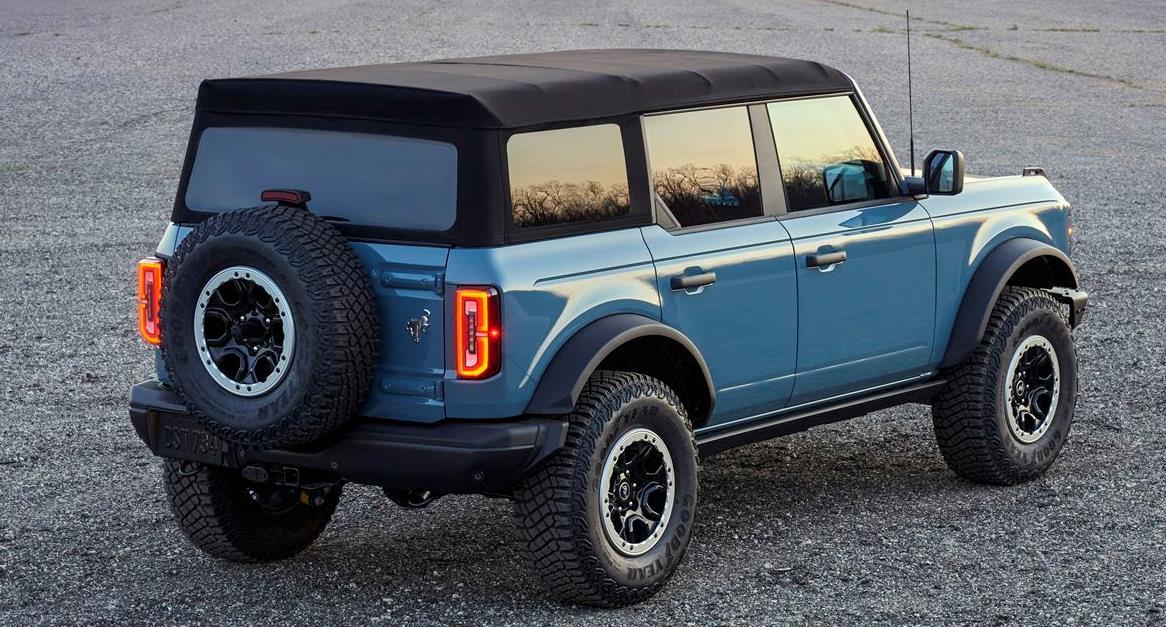
3 minute read
2022- Ford Bronco Badlands
2022 Ford Bronco Badlands - $42,095.
By Ella Patterson
Advertisement
The Badlands vehicle is equipped for adventure. Aside from a limited run of First Edition models, it's the most expensive of the Sport's five available trim levels and the best performer, both on and off road. At $34,315 to start, it costs $6000 more than the base model and brings a long list of upgrades. A turbocharged 2.0-liter inline-four with 250 horsepower and 277 pound-feet of torque resides under its hood, replacing the 181-hp turbocharged three-cylinder that powers the Base, Big Bend, and Outer Banks models. An eight-speed automatic transmission is standard across the board.
Badlands models also get unique suspension tuning with about an inch more ground clearance than lesser trims. To cope with the additional weight of the four-cylinder, taller and slightly stiffer springs are fitted, as are front dampers with hydraulic rebound stops for soaking up harsh, full-jounce impacts. Ford claims that the Badlands's 7.4 inches of wheel travel is the best in its class. With 8.8 inches of ground clearance, the Badlands has a hair more clearance than a Jeep Cherokee Trailhawk. To gain a few extra millimeters of space, Ford's engineers tucked the Sport's exhaust system up closer to the floor pan. Its 30.4-degree approach angle is also better than the Jeep's, although the Cherokee offers slightly better breakover and departure angles.
All-wheel drive is standard on all Bronco Sports, but the Badlands features a torque-vectoring rear differential that borrows tech from the Focus RS. Its Terrain Management System also expands from five modes to seven, gaining Mud/Ruts and Rock Crawl settings. Although its dampers are passive units, the drive programs alter the tuning of the throttle, transmission, brake response, steering effort, and the all-wheel-drive system for the chosen conditions.
Also included on the Badlands are skid plates for the powertrain and fuel tank, an off-road cruise-control-like system that works up to 20 mph, a front-facing camera, front tow hooks, steering-wheelmounted paddle shifters, and 28.5-inch-tall all-terrain tires. Pirelli Scorpio A/Ts are standard, but our test vehicle wore optional 235/65R-17 Falken WildPeaks, which cost $495 and are slightly wider, a half-inch taller, and have a more aggressive tread pattern. The knobby tires fill the Bronco Sport's wheel wells and come wrapped around 17-inch wheels that have a purposefully old-school look. Although they look like steelies, they're aluminum. We like them a lot. A Ford engineer tells us owners can upgrade to 30.5-inch tires without any clearance problems, but 31s won't fit without increasing the height of the suspension.
Even better, the tires' off-road credentials don't impede the Sport's on-road stopping ability. In our 70-mph-to-zero braking test, the Bronco came to a halt in a curt 163 feet. That beats everything but the Escape from our recent comparison test of six compact crossovers. Unfortunately, our Michigan skid pad was covered with snow, so we can't comment on the Falkens' lateral grip capability.
Balancing Comfort and Capability
Ford says it had this vehicle in mind when it designed its C2 platform, making additional reinforcement to the structure unnecessary. Torsional rigidity is the same as in the Escape, and it lends the Bronco Sport a solid feel. Making the Sport capable of safely fording nearly two feet of water required only slight modifications to the engine's air-intake plumbing and fitting more robust bottom door seals.
The Sport's 105.1-inch wheelbase is 1.6 inches shorter than the Escape's, which both improves its breakover angle and gives it a stockier stance. In the metal, its boxy silhouette, slab body sides, and muscular wheel-well flares give it presence, but it's smaller than it looks—8.0 inches shorter than the Escape and essentially the same size as the Jeep Compass except that the Bronco is six inches taller. Our only aesthetic complaint is the integration of its backup camera, which appears glued to the rear hatch as an afterthought. The Bronco Sport feels bigger on the road than it is, thanks to its ample headroom, heavily weighted steering, and firm ride. It feels substantial and rather truck-like in how its suspension translates a significant amount of road texture to your backside. Highway expansion joints kick you up out of the seat.
PHOTO CREDIT:FORD.COM










